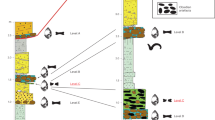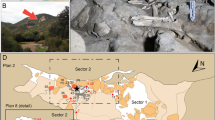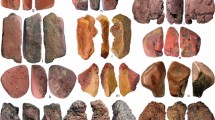Abstract
AN examination of the whole of the material now available makes it abundantly clear as to the general plan upon which the Sligo implements were made (see NATURE, Aug. 20, p. 260). The raw material used is limestone, and this rock is present upon the Sligo coast in the form of horizontal layers about 1 foot thick and 11/2 feet wide. These layers frequently break with a fracture vertical to their longer axis, thus producing oblong masses of limestone such as is outlined in Fig. 1 (A).
This is a preview of subscription content, access via your institution
Access options
Subscribe to this journal
Receive 51 print issues and online access
$199.00 per year
only $3.90 per issue
Buy this article
- Purchase on Springer Link
- Instant access to full article PDF
Prices may be subject to local taxes which are calculated during checkout
Similar content being viewed by others
Author information
Authors and Affiliations
Rights and permissions
About this article
Cite this article
BURCHELL, J., MOIR, J. Method of Manufacture of the Sligo Implements. Nature 120, 443–444 (1927). https://doi.org/10.1038/120443a0
Issue Date:
DOI: https://doi.org/10.1038/120443a0
Comments
By submitting a comment you agree to abide by our Terms and Community Guidelines. If you find something abusive or that does not comply with our terms or guidelines please flag it as inappropriate.



